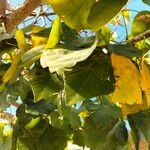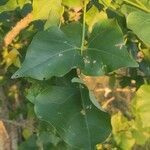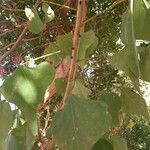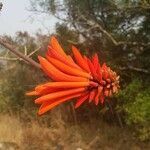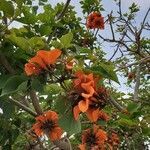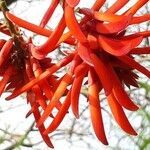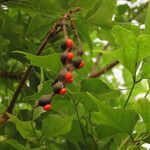Tree 2-12(20) m tall, bark grey or grey-brown, smooth, not corky, with prickles; branches armed with prickles. Leaves scattered or clustered at ends of twigs, unarmed, glabrous; terminal leaflet 4.5-12(13) × 3.5-10(12) cm, broadly to very broadly ovate or deltate, sometimes longer than broad, acuminate; lateral leaflets 4-11 x 2.5-7 cm, broadly ovate, asymmetric at base; petiole 3.5-8.5 cm long, glabrous when mature, with 0-2 prickles; rhachis 8.5 cm long; petiolules 3-7 mm long; stipules 2-3 mm long, ovate, caducous. Inflorescence a dense terminal pseudoraceme; flowers declined towards the rhachis; peduncle (4)6-22 cm long, ferruginous hairy becoming glabrous at maturity; rhachis 2-10 cm long; bracts 4 mm long, ovate; pedicels 2 mm long; bracteoles 3-4 mm long, linear, caducous. Calyx 1-1.4 cm long, 2-lipped, tomentose. Corolla red, glabrous; standard 2.4-5.5(6.5) × 1-2.1 cm, elliptic to obovate, not reflexed, enclosing other petals and stamens; wings 9-11 x 3-4 mm, oblong; keel 7-10 x 3-5 mm, narrowly oblong, the petals fused along their lower margin. Vexillary stamen free, others fused into a sheath along two-thirds of their length. Ovary 1-1.7 cm long, narrowly cylindrical. Pod black, 12-30 x 1.2-1.8 cm, irregularly constricted between the (1)3-8 seeds, glabrous when mature. Seeds red, 6-8 x 4-6 x 2-3 mm; hilum black, 3 mm long, elliptic.
Tree, up to 12 m high. Leaves widely ovate, base cuneate, apex acute. Stipules glandular. Flowers are normally brilliant scarlet, deflexed at anthesis, appearing before new leaves. Petals: standard scarlet, long and narrow, slightly arcuate, enclosing stamens; keel and wing relatively short; wings exceeding keel. Stamens diadelphous. Flowering time winter to early spring. Pod subligneous, sickle-shaped, smooth. Seeds scarlet or vermilion red; hilum oval, depressed, blackish.
Leaves scattered or clustered at ends of twigs, unarmed, glabrous; terminal leaflet 4.5–12(13) × 3.5–10(12) cm, broadly to very broadly ovate or deltate, sometimes longer than broad, acuminate; lateral leaflets 4–11 × 2.5–7 cm, broadly ovate, asymmetric at base; petiole 3.5–8.5 cm long, glabrous when mature, with 0–2 prickles; rhachis 8.5 cm long; petiolules 3–7 mm long; stipules 2–3 mm long, ovate, caducous.
Inflorescence a dense terminal pseudoraceme; flowers declined towards the rhachis; peduncle (4)6–22 cm long, ferruginous hairy becoming glabrous at maturity; rhachis 2–10 cm long; bracts 4 mm long, ovate; pedicels 2 mm long; bracteoles 3–4 mm long, linear, caducous.
Corolla red, glabrous; standard 2.4–5.5(6.5) × 1–2.1 cm, elliptic to obovate, not reflexed, enclosing other petals and stamens; wings 9–11 × 3–4 mm, oblong; keel 7–10 × 3–5 mm, narrowly oblong, the petals fused along their lower margin.
Tree 2–12(20) m tall, bark grey or grey-brown, smooth, not corky, with prickles; branches armed with prickles.
Pod black, 12–30 × 1.2–1.8 cm, irregularly constricted between the (1)3–8 seeds, glabrous when mature.
Vexillary stamen free, others fused into a sheath along two-thirds of their length.
Seeds red, 6–8 × 4–6 × 2–3 mm; hilum black, 3 mm long, elliptic.
Ovary 1–1.7 cm long, narrowly cylindrical.
Calyx 1–1.4 cm long, 2-lipped, tomentose.
